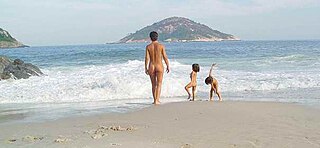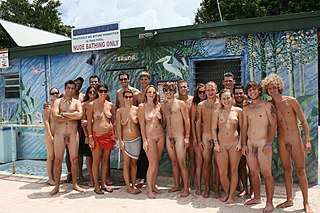Naturism in Argentina (or nudism in Argentina) is the movement supporting the practice of social nudism in the country, which began to be regularly performed in 1934 and it is being practiced nowadays, despite still being a taboo topic in the Argentine society. The most important nudist destinations include Escondida Beach, Querandí Beach and Eden club in Buenos Aires Province, as well as Yatan Rumi in the Córdoba sierras.
There is a precedent of nudism in Buenos Aires from the 1810s years, when the bathers went to the Buenos Aires city beaches and there bathed naked. This custom met opposition and was confronted by the authorities of that time with legal limits and fines, as well as trying to establish gender-segregated areas in the beaches with no much success. [1]
The naturist movement per se was originated during the 1930s. Individuals like Francisco Verding, Agustín Puyo and Roberto Ferrer practiced nudism privately, but after they felt the wish to create a community to gather together naked, in 1934 they established in Castelar, Morón Partido, the First Naturist Nudist Association of Argentina (Primera Asociación Naturo Desnudista Argentina, or PANDA). When they performed nudity in public, soon the conservative parts of the society rejected these activities and the police interceded. Due to this situation, PANDA members —sometimes nicknamed as "adamites"— purchased a land on the shores of Reconquista river, 4 kilometers away from the old Márquez Bridge in Ituzaingó, being this the first truly naturist beach of Argentina. Then this association reached 90 members, 50 men and 40 women. They met together on Sundays to enjoy activities such as physical exercises, rhythmic dances, games, to watch the nature or to socialize, and at the end they bathed in the river. But at that time this led to having people lurking around the land to peek the naturist colony to see the naked people there. [2] [3] This association remained until the 1980s when it was broken up. In 1987 surfaced a new naturist community known as NAT by Cristian Vogt and Jorge Biagosh, in a country villa called "Los Galpones" near Benavídez city, Tigre Partido, Buenos Aires Province, which operated until March 1999. [4]
On 10 January 1994, from an undertaking of actress Moria Casán and her then partner Luis Vadalá established Franka Beach (Playa Franka), an area in the coast of Argentina of Mar Chiquita Partido, Buenos Aires Province, where women could freely be topless. There was a demonstration of "brassiere cutting" to open the new summer season and as a symbolic representation to put an end to prejudices against self acceptance and to advocate for liberty, inclusion and gender equality. Later a parador or a beach facility was erected to serve the beach. But Franka Beach experience started to fell into crisis which, due to the pressure of some neighbours of the resort town to have it closed due to morality reasons but also mainly due to the debts from the shareholders Antonio Fraiese and Luis Vadalá after they failed to pay the beach license fee for eight years, on 3 September 2004 the intendant of Mar Chiquita cancelled the concession. [5] [6]
Nowadays the Association for the Argentine Naturist Nudism (Asociación para el Nudismo Naturista Argentino, or APANNA), a nonprofit organization congregate Argentine naturists and was established to promote naturism. It gained state authorization in September 2005. [7] [8]
Escondida Beach (Playa Escondida) is located in Chapadmalal, General Pueyrredón Partido, Buenos Aires Province, being the first beach of optional-clothing beach, established in 2001. [7] People such as elderly, families and couples attend the beach, the latter comprising half of the visitors attending there. [9]
Another naturist beach is Querandí Beach (Playa Querandí), optional-clothing, located in Villa Gesell Partido and designated as naturist beach by the local government in 2008. [3] [7]
In a country house of three hectares in La Reja town, Moreno Partido, Buenos Aires Province, lies the naturist club Edén, established in 1999. This club's activities include volleyball, trekking, singing and shared meals. [7]
On the Sierra Grande, 14 kilometers away from Tanti city of Punilla Department, Córdoba Province, there is a naturist reservation known as Yatan Rumi, established in 2003. The people who attends here include families, couples without children and single men and women. In this destination a nudist marathon is held, and other activities are naked tango dancing, parties and other nature linked activities. [7] [10]

Naturism is a lifestyle of practicing non-sexual social nudity in private and in public; the word also refers to the cultural movement which advocates and defends that lifestyle. Both may alternatively be called nudism. Though the two terms are broadly interchangeable, nudism emphasizes the practice of nudity, whilst naturism highlights an attitude favoring harmony with nature and respect for the environment, into which that practice is integrated. That said, naturists come from a range of philosophical and cultural backgrounds; there is no single naturist ideology.

Topfreedom is a cultural and political movement seeking changes in laws to allow women to be topless in public places where men are permitted to be barechested, as a form of gender equality. Specifically, the movement seeks the repeal or overturning of laws which restrict a woman's right not to have her chest covered at all times in public.
The International Naturist Federation (INF) or Fédération naturiste internationale (FNI) or Internationalen Naturisten Föderation (INF) is the global umbrella organisation representing official national naturist societies.

The American Association for Nude Recreation (AANR) is a naturist organization based in the United States.
Playa Zipolite is a beach community located in San Pedro Pochutla municipality on the southern coast of Oaxaca state in Mexico between Huatulco and Puerto Escondido.

Christian naturism is the practise of naturism or nudism by Christians.

Social nudity is the practice of nudity in relatively public settings not restricted by gender. This occurs both in public spaces and on commercial property, such as at a naturist resort.
Gay naturism or LGBT naturism concerns a lifestyle of gay people in which nudity, especially in a communal context, is viewed as natural, positive and healthy. While naturist clubs and resorts in the United States date back to the 1930s, gay naturist organizations did not emerge until the early 1980s. Separate from official naturist clubs, gay individuals have long congregated in locally-known gay beaches in many countries, especially in Europe and North America.

Nude recreation consists of recreational activities which some people engage in while nude. Historically, the ancient Olympic Games were nude events. There remain some societies in Africa, Oceania, and South America that continue to engage in everyday public activities—including sports—without clothes, while in most of the world nude activities take place in either private spaces or separate clothing optional areas in public spaces. Occasional events, such as nude bike rides, may occur in public areas where nudity is not otherwise allowed.

A nude beach, sometimes called a clothing-optional or free beach, is a beach where users are at liberty to be nude. Nude beaches usually have mixed bathing. Such beaches are usually on public lands, and any member of the public is allowed to use the facilities without membership in any movement or subscription to any personal belief. The use of the beach facilities is normally anonymous. Unlike a naturist resort or facility, there is normally no membership or vetting requirement for the use of a nude beach. The use of nude beach facilities is usually casual, not requiring pre-booking. Nude beaches may be official, unofficial, or illegal.
Anarcho-naturism, also referred to as anarchist naturism and naturist anarchism, appeared in the late 19th century as the union of anarchist and naturist philosophies. In many of the alternative communities established in Britain in the early 1900s, "nudism, anarchism, vegetarianism and free love were accepted as part of a politically radical way of life". In the 1920s, the inhabitants of the anarchist community at Whiteway, near Stroud in Gloucestershire, "shocked the conservative residents of the area with their shameless nudity". Mainly, it had importance within individualist anarchist circles in Spain, France, Portugal and Cuba.
Felicity Jones is an American naturist who blogs pseudonymously for Young Naturists America. She is from Newton, New Jersey and is known for her activism in the nudism and feminism movements. Jones is a feminist who promotes female self-acceptance feminist thinking and opposes fat shaming. She encourages acceptance of sexuality and social nudism in daily life. She has been a contributor to Failure Magazine.
Naturism is a cultural and social movement practicing, advocating and defending social nudity in private and in public. It is particularly strong in Germany where it goes under the name Freikörperkultur (FKK). It refers to a lifestyle based on personal, family and/or social nudism in the "great outdoors" environment. Naturism grew out of the German Lebensreform movement and the Wandervogel youth movement of 1896, and has been adopted in many neighbouring European countries and was taken by the German diaspora to North America and other continents.
Naturism in the United States is the practice of social nudity as a lifestyle that seeks an alternative to the majority view of American society that considers nakedness and sexuality to be taboo based upon the legacy of Puritan and Victorian attitudes. Enthusiasm for naturism began in the late 1920s with the establishment of members-only communities where naturists could gather to socialize and enjoy recreation without clothing in an environment that was no more sexual than that experienced while clothed. In later decades some groups began advocating for more general acceptance, and the opening up of public land to clothing-optional recreation.

A naturist resort or nudist resort is an establishment that provides accommodation and other amenities for guests in a context where they are invited to practise naturism – that is, a lifestyle of non-sexual social nudity. A smaller, more rustic, or more basic naturist resort may be called a naturist camp.
La Sirena Beach is a beach located around two kilometers north of Aguas Dulces resort, in Rocha Department, Uruguay. It was officially designated as a naturist beach by the authorities of the government of Rocha.
Naturism in Uruguay is practiced at least since the 1960s, firstly by foreigners coming to Uruguay and later by Uruguayan naturists. It is being practiced on the two officially designated naturist beaches : Chihuahua beach in Maldonado that is the most known, and the other is La Sirena Beach in Rocha.